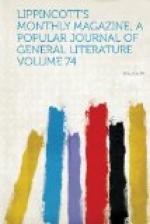As we leave Setif we are overtaken by the lumbering stage-coach, which plunges and jolts over the road to Sibou-Areridj—a coach apparently about the age of the carriage of General Washington, for Algeria is the infirmary of all the worn-out French diligences. Sibou-Areridj is reached and passed, and a few miles farther on is encountered an Arab douar, or assemblage of tents forming a tribal fraction. This woven village, although we have attained the limits of Kabylia, reminds us that we have not yet reached the Kabylian abodes: an Arab lives in a tent in all localities outside the great cities—a Kabyle, never. However poor the hut in which the Kabylian artisan starves and labors, it must be a solid mansion founded upon the soil, and its master must feel himself a householder. Our douar proves to be an encampment belonging to the marabouts, or high religious orders, situated on a large plot of ground in the ownership of the saints, and extending up to the limits of Kabylia. Composed of a circle of tents numbering about fifty, and exhibiting numbers of fine horses picketed near the tent-doors, it is as fine a specimen as we shall see of the patriarchal life inherited from the unfatherly father of Ishmael. The pavilions are of a thick camel’s hair stuff, very laboriously made by the women, which swells up in the rain and completely excludes moisture. They are striped brown and yellow, but a splendid tabernacle in the centre, of richer colors and finer fabric, bears at the apex a golden ball with plumes of ostrich feathers, the sign of authority. This tent is oval in form, resembling an overturned ship. It is the residence and office of the sheikh, or chief of the douar: several douars united form a tribe, governed by a caid. We venture to visit the sheikh, assured by our spahi guides that we shall be welcome. We are received blandly by the officer, offensively by his dogs, a throng of veritable jackals who scream around our feet as we enter. The interior, rich and severe at once, exhibits saddles and arms, gilded boxes and silken curtains, without a single article of furniture. The sheikh treats us to mild tobacco in chiboukhs—another sign that we are not yet in Kabylia: never is a Kabyle seen smoking. We reciprocate by offering coffee, made on the spot over our spirit-lamp—a process which the venerable sheikh watches as a piece of jugglery, and then dismisses us on our way with the polite but final air which Sarah may be supposed to have used in dismissing Hagar.
[Illustration: THE STONE TURBAN.]
The douar, like a city, has suburbs of greater squalor than its interior, and among them, under the palm trees, we see women washing clothes or engaged in the manufacture of couscoussou, a dish common to the Arab, the Kabyle and the traveler hereabouts, and so important that a description of its preparation may be acceptable.




